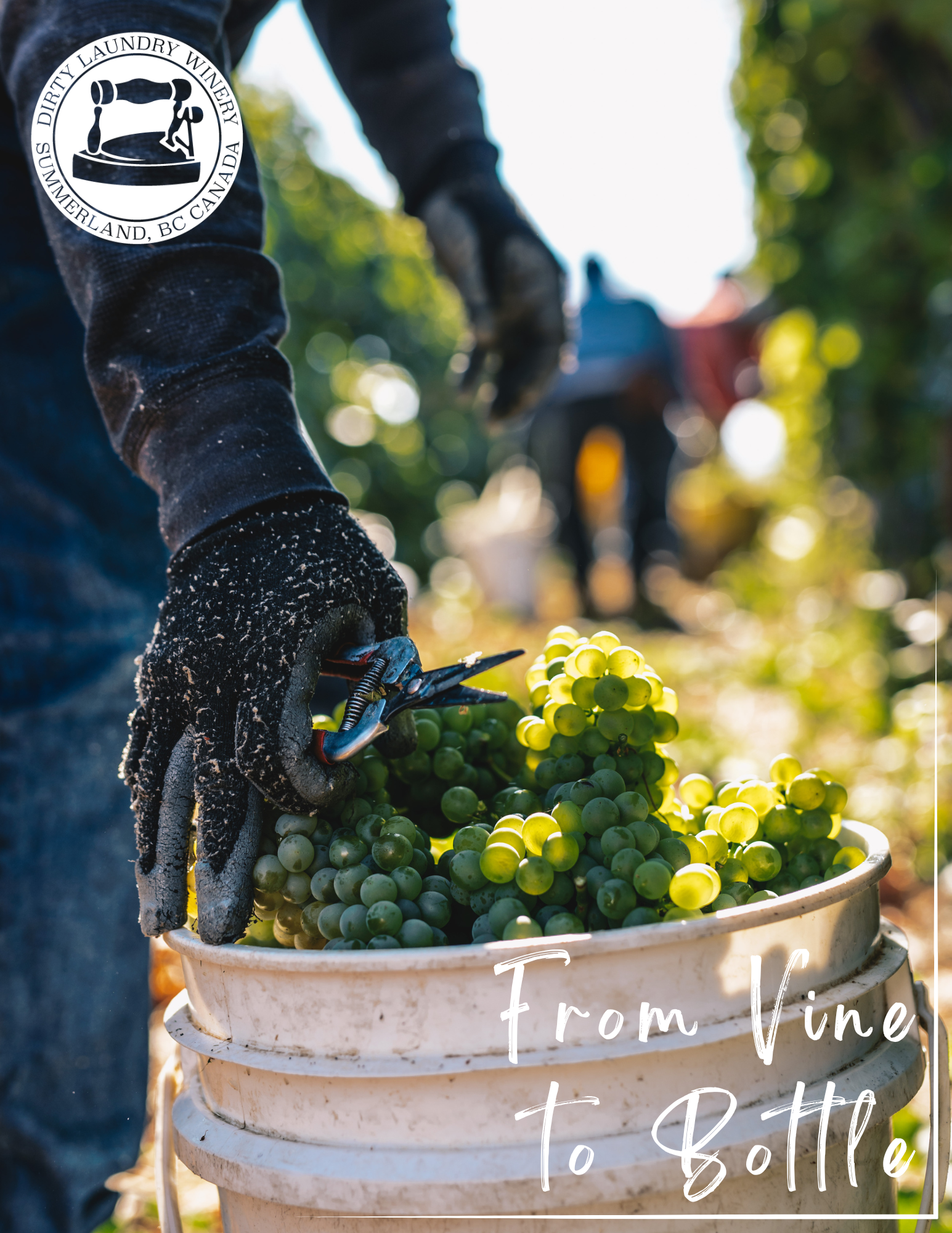All You Need to Know About Harvest Season: How Grapes go From Vine to Bottle

There’s something truly fascinating about harvest season in the Okanagan’s wine country. As summer fades into fall, vineyard-covered hills come alive with vibrant colour, and orchards are buzzing with activity. What is not so visible is the journey happening behind the scenes — a process that transforms humble grapes into the wine we love.
1. The Countdown to Harvest
Despite what you might think, harvest season doesn’t begin with picking. All year long, vintners have carefully tended to their vines: pruning in the winter, managing canopy growth in the spring, and protecting clusters in the summer.
The Okanagan valley’s diverse microclimates mean that harvest timing varies widely depending on location and grape variety. Many of the red grapes used in Dirty Laundry’s wine are sourced from arid vineyards in the hotter climate of Osoyoos and Oliver, BC. We work with several growers in the South to source red grapes that need some more heat and sunshine to fully develop. The grapes used in our white wines vary in location. Our Hush White blend, for example, uses grapes from the Yakima Valley in Washington, whereas our Madam’s Gewurtztraminer sources 100% of its grapes from Summerland, BC. Wherever the grapes are grown, typically by late August to early October, winemakers are walking rows daily, tasting berries and checking sugar levels, acidity, and ripeness, testing them in the lab to decide the perfect moment to pick. This is a delicate balance: too early and the wine may lack flavour; too late and the grapes may lose acidity or become overripe.This isn’t just about numbers—it’s about instinct, history, and experience.
2. Picking with Purpose
When the grapes hit that sweet spot, it’s time to harvest. Depending on the winery, this might be done by hand (ideal for preserving delicate grape skins and ensuring quality) or by a grape harvester machine for efficiency. At Dirty Laundry, we pick all of our locally grown BC grapes by hand, allowing us to be selective and ensuring only the best fruit makes it to the crush pad. Grapes are typically picked early in the morning (around 6am) to preserve freshness and prevent unwanted fermentation from starting too soon—critical in our valley where daytime temperatures can still be surprisingly warm in early fall. But weather can change quickly here (with frost sometimes just around the corner), so there’s often a race against time. One cold snap can change everything.
3. From Bins to Crush
Once picked, the freshly harvested grapes are rushed to the winery’s crush pad where they are received and prepared for fermentation.
- Grapes arrive from the vineyard and are weighed, then cleaned of leaves, stems, and damaged fruit by hand or machine.
- Stems are removed, and grapes may be gently crushed to release juice. White varietals like Riesling, Pinot Gris, and Chardonnay are typically pressed immediately to preserve their crisp, clean character.
- The juice (and skin for red wine) is collected. This is the wine “must”. Red grapes such as Merlot, Cabernet Sauvignon, and Syrah are left to ferment on their skins to extract deep colour, flavour and tannins.
- Juice or must is pumped or moved to fermentation tanks. This is where the transformation from fruit to wine begins.
The crush pad is key to maintaining grape quality and setting the stage for successful winemaking.
4. Fermentation: Where the Magic Happens
Fermentation is the heart of winemaking. Natural or added yeasts convert grape sugars into alcohol and carbon dioxide. This can take anywhere from a few days to several weeks, depending on the style of wine. Winemakers closely monitor temperature, perform cap management for red wine up to twice daily, and taste constantly to guide the process.
Cap management is the process of handling the “cap” (made up of grape skins, seeds, and stems that rise to the top of the fermenting must due to carbon dioxide released during fermentation) and ensuring the cap keeps in contact with juice. This helps to retain the red colour of the wine, and ensures full flavour development as the grape skin contributes to complex aromas. Additionally, a dry, undisturbed cap can lead to bacterial growth, so proper cap management is essential.
The frequency of cap management depends on grape variety, desired wine style (e.g., bold vs. soft), fermentation temperature, and winemaker preference.
5. Aging and Maturation
Once fermentation is complete, wines are pressed (if red), clarified, and moved into tanks or barrels to age. Oak barrels may lend flavours like vanilla, spice, or toast, while stainless steel preserves fresh, fruity notes. During this time—anywhere from a few months to several years—wines soften, integrate, and develop complexity.
The aging process differs significantly between red and white wines. Our
2022 Cabernet Sauvignon for example, was aged for 15 months in oak barrels with 75% French and 25% American. In processing we crushed and destemmed the grapes, then left them to cold soak for a day before fermentation was initiated. To make our
2024 WooWoo Gewurtztraminer, half of the fruit was cold-soaked on the skins before being pressed into stainless steel tanks, where it underwent spontaneous fermentation. The other half was crushed, destemmed, and pressed directly into the tank, where it was cold-settled, then racked and inoculated for a cool fermentation to preserve varietal character and aroma.
The aging process here is influenced by the valley’s natural elements—cool nights, clean air, and a slower pace that lets the wine develop with balance and finesse.
6. Bottling the Story
When the winemaker decides the wine is ready, it’s filtered (if needed), bottled, and sealed. Some wines are released quickly, fresh and vibrant. Others are laid down in cellars to evolve. But each bottle tells the story of that vintage—its weather, its vineyard, and the care that went into it. Was it a hot, dry year producing bold reds? Or a cooler vintage with elegant acidity?
7. From Glass to Experience
Finally, that wine finds its way to your table. Whether you're sipping a chilled Hush Rosé on a lakeside patio in Kelowna or cozying up with a glass of Malbec by the fire in Naramata, you’re tasting more than just wine. You’re tasting the result of months (and sometimes years) of craft and care—all sparked by the simple act of harvesting grapes at just the right time. Many Okanagan wineries open their doors during harvest for tastings, events, and tours. If you visit during this special season, you might just catch a glimpse of grapes being crushed or barrels being filled, offering a behind-the-scenes look at winemaking in action.
So the next time you raise a glass, take a moment to toast the journey from vine to bottle that made it possible.

